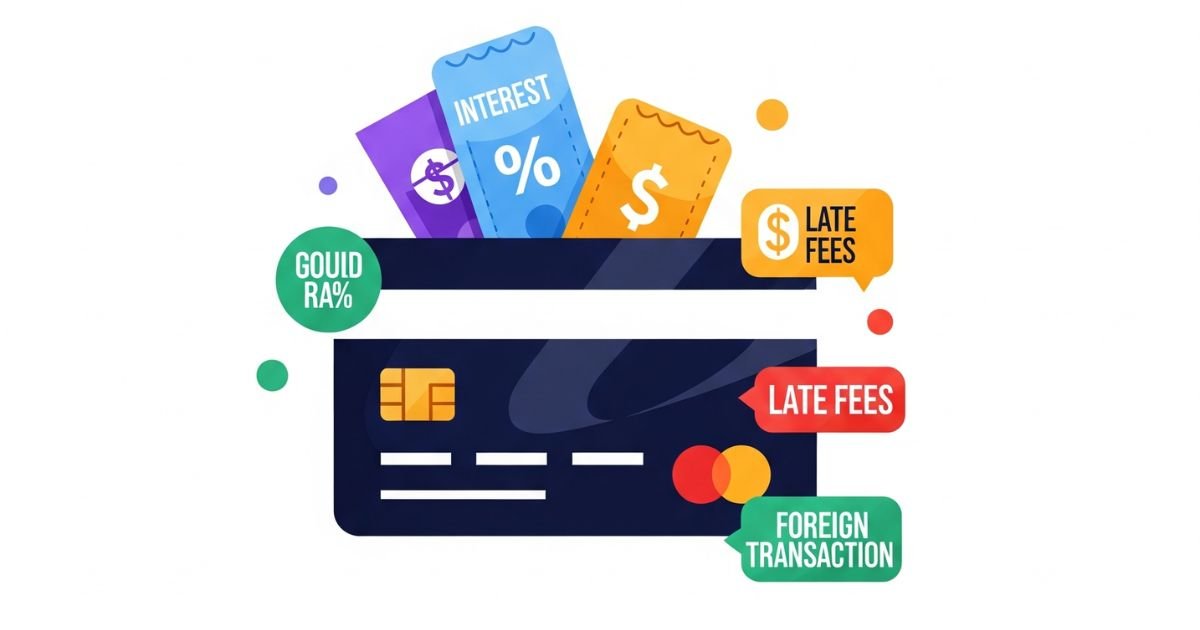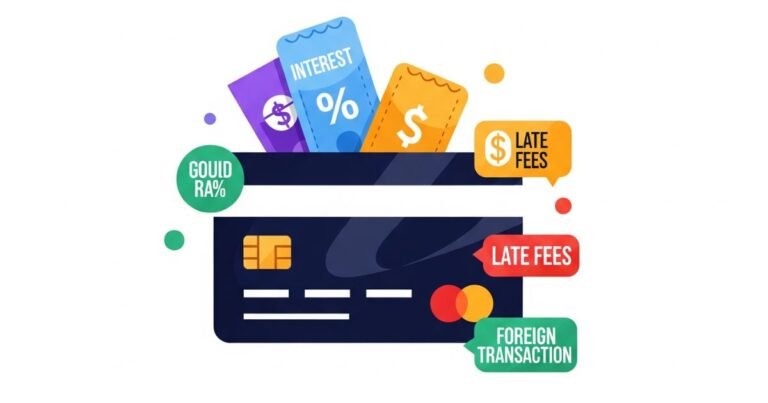
Credit cards are a convenient way to pay for things, but they come with charges that can catch you off guard if you are not careful. Whether you are new to credit cards or have been using one for years, understanding these charges can save you money and stress. In this blog, we will break down the most common credit card charges, explain how they work, and share tips to manage them. Our goal is to make this topic easy to understand, even if you are not a financial expert. Let us dive in!
What Are Credit Card Charges?
Credit card charges are fees or costs added to your account by the credit card company. These charges can come from using the card, missing payments, or even just owning the card. Some charges are easy to avoid, while others might feel like a surprise if you do not read the fine print. Knowing what these charges are and why they happen can help you make smarter choices with your credit card.
Common Types of Credit Card Charges
Credit card companies apply different types of fees depending on how you use the card. Below, we will go over the most common ones you are likely to see on your statement.
Annual Fees
Many credit cards charge an annual fee just for having the card. This fee can range from $25 to $500 or more, depending on the card’s benefits. Premium cards with rewards like travel points or cashback often have higher annual fees. Basic cards might have no annual fee at all.
- Why it matters: The annual fee is charged whether you use the card or not.
- How to avoid it: Look for no-annual-fee cards if you do not need fancy rewards. If your card has a high fee, check if the rewards are worth it. For example, a $99 annual fee might be okay if you earn $200 in cashback each year.
Interest Charges (Finance Charges)
When you carry a balance on your credit card, you will likely pay interest. This is also called a finance charge. The interest rate, or APR (Annual Percentage Rate), varies by card and can be anywhere from 15% to 30% or higher.
- How it works: If you do not pay your full balance by the due date, the card issuer charges interest on the unpaid amount.
- Tip to avoid it: Pay your balance in full each month before the due date. Most cards offer a grace period (usually 21-25 days) where you can avoid interest if you pay on time.
Here is a quick example of how interest adds up:
| Balance | APR | Monthly Interest |
|---|---|---|
| $1,000 | 20% | $16.67 |
| $5,000 | 20% | $83.33 |
This table shows how a higher balance leads to more interest. Paying off your balance quickly can save you a lot.
Late Payment Fees
If you miss the payment due date, you will likely face a late payment fee. This fee is usually between $25 and $40, depending on your card issuer. Missing payments can also hurt your credit score.
- How to avoid it: Set up automatic payments or reminders to pay on time. Some issuers waive the first late fee as a courtesy, so call and ask if it happens to you.
Balance Transfer Fees
A balance transfer is when you move debt from one credit card to another, often to get a lower interest rate. However, most cards charge a fee for this, typically 3-5% of the transferred amount.
- Example: Transferring a $2,000 balance with a 3% fee costs $60.
- Tip: Look for cards with promotional 0% APR on balance transfers to save on interest, but check the fee first. Some cards waive this fee during introductory offers.
Cash Advance Fees
Using your credit card to get cash, like at an ATM, comes with a cash advance fee. This is usually a flat fee (like $10) or a percentage of the cash amount (like 5%), whichever is higher. Cash advances also have a higher interest rate than regular purchases, and there is no grace period, so interest starts immediately.
- Why avoid it: Cash advances are expensive and can add up fast.
- Alternative: Use a debit card for cash withdrawals to avoid these fees.
Foreign Transaction Fees
If you use your card outside your home country or for online purchases in a foreign currency, you might face a foreign transaction fee. This is typically 1-3% of the purchase amount.
- Example: A $100 purchase with a 3% fee adds $3 to your bill.
- How to avoid it: Choose a card with no foreign transaction fees, especially if you travel often or shop internationally.
Over-Limit Fees
Some cards allow you to spend over your credit limit, but this comes with an over-limit fee, usually around $25-$35. Not all cards charge this fee, and some require you to opt-in for over-limit protection.
- Tip: Keep track of your spending to stay within your limit. Many card issuers send alerts when you are close to your limit.
How Credit Card Charges Affect You
These charges can add up quickly and make your credit card more expensive than you expect. For example, carrying a balance with a high APR can lead to hundreds of dollars in interest over time. Late payments not only cost you fees but can also lower your credit score, making it harder to get loans or better card offers in the future.
Here is a quick look at how charges impact your wallet:
| Charge Type | Typical Cost | Impact on Budget |
|---|---|---|
| Annual Fee | $25-$500/year | Fixed cost |
| Interest (APR) | 15-30% | Grows with balance |
| Late Payment Fee | $25-$40 | One-time hit |
| Cash Advance Fee | $10 or 5% | Expensive for cash |
By understanding these costs, you can plan your spending and payments to minimize fees.
Tips to Manage Credit Card Charges
Now that you know the common charges, here are some practical ways to keep them under control:
- Pay on time: Set up auto-payments or calendar reminders to avoid late fees and interest.
- Choose the right card: Pick a card that fits your needs. If you pay your balance in full, a no-annual-fee card might be enough. If you travel, look for no foreign transaction fees.
- Track your spending: Use your card’s app or website to monitor your balance and avoid over-limit fees.
- Avoid cash advances: Use other options, like a debit card, for cash needs.
- Read the fine print: Before signing up for a card, check the terms for fees and interest rates. Compare cards to find the best deal.
Common Myths About Credit Card Charges
There are some misconceptions about credit card charges that can lead to confusion. Let us clear up a few:
- Myth: All credit cards have the same fees.
Truth: Fees vary widely between cards. Some have no annual fee, while others charge high fees for premium benefits. - Myth: Interest only applies if you miss a payment.
Truth: Interest applies to any unpaid balance after the grace period, even if you pay the minimum. - Myth: You can ignore small fees.
Truth: Small fees, like foreign transaction fees, can add up over time, especially if you use your card often.
FAQs About Credit Card Charges
Q. Why do credit cards charge so many fees?
Credit card companies use fees to cover their costs, like processing payments and offering rewards. Some fees, like late payment fees, encourage responsible use. To avoid fees, read your card’s terms and pay on time.
Q. Can I negotiate credit card fees?
Yes, sometimes! Call your card issuer and ask for a fee waiver, especially for annual or late fees. If you are a loyal customer, they might agree to keep you happy.
Q. How do I know if a card’s fees are worth it?
Compare the card’s benefits (like rewards or travel perks) to the fees. If the benefits save you more than the fees cost, it might be worth it. For example, a $99 annual fee is okay if you earn $150 in rewards.
Conclusion
Credit card charges can seem overwhelming, but they do not have to be. By understanding the types of fees, how they work, and how to avoid them, you can use your credit card wisely. Pay your balance on time, choose a card that fits your lifestyle, and keep an eye on your spending. These simple steps can help you save money and avoid surprises on your statement. With a little care, your credit card can be a helpful tool instead of a costly one.
Disclaimer: This blog is for informational purposes only and should not be considered financial advice. Always consult with a financial advisor or read your credit card agreement for specific details about your card’s fees and terms.
